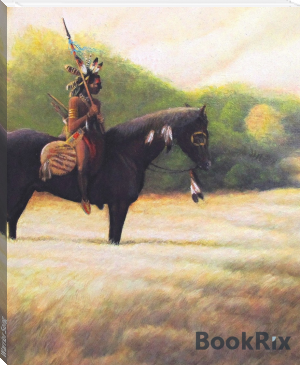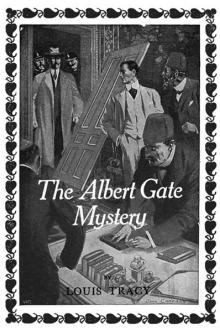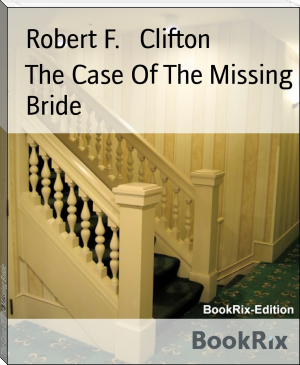Warrior Song, Robert F. Clifton [good books to read for teens TXT] 📗

- Author: Robert F. Clifton
Book online «Warrior Song, Robert F. Clifton [good books to read for teens TXT] 📗». Author Robert F. Clifton
“So young to have taken her own life. What a shame”, McKenzie thought to himself. Picking up the next cut newspaper article with a printed photograph was a writing of a July fourth celebration at Fort Robinson. McKenzie read the caption saying that “Captains Conrad Parker seen with his fiance' Dorothea Willett enjoy the Independence Day celebration along with Captain Alonzo Willett father of the future bride” “Son of a bitch!”, said McKenzie in amazement. He closed the file then selected the one labeled, “Medical Records U.S. Army Dependents, Third Calvary”. The first medical report was that of Selma Willett. After reading the army doctors report McKenzie realized that the wife of then Captain Willett was originally treated for Cellulitis of the left breast. Later Doctor Luther Simpson, M.D. Captain, U.S. Army Medical Service diagnosed Selma Willett as having terminal breast cancer.
McKenzie selected the next sheet of paper and read the name, Dorothea Willett, W.F. age 17 complaint of vaginal burning and discharge. Diagnosed as gonorrhea, treatment, silver nitrate. After closing the file he got up from the table and carried them back to the soldier on duty. “Thank you”, he said to the clerk. “You're welcome sir.”.
Back in his room at Fort Myer McKenzie sat deep in thought. As he did he paced slowly back and forth. Finally he took a seat at the small table that served as a desk and on a yellow, blue lined tablet put all of his ideas and thoughts to paper. When he was finished he read his noted over and over attempting to prove to himself that he was wrong. He wasn't. “I have one more thing to do. Hopefully, I'll be wrong”, he thought to himself.
The next day, Sunday, November 14. 1897 Lieutenant Alan McKenzie entered the building that housed the Military Division of The Atlantic. A sentry came to present arms and after returning the salute and showing his credential was granted entrance to Colonel Willetts office. Inside, McKenzie took off his uniform cap and placed his brief case on top of the large walnut desk. He looked around the large room then walked to the windows. Needing light he raised the shades allowing the mid-morning sunlight to enter. Next he went to the desk and standing behind it began opening the drawers. In the large middle drawer he found the usual plain sheets of military embossed stationery, pencils, an Indian rubber eraser and a faded, black and white photograph of Selma and Dorothea Willett taken some time ago. McKenzie judge the girl in the photo to be about ten or eleven years old at the time. He closed the middle drawer and opened the top left hand drawer. When he did he saw what he was looking for. He picked it up. Then, opening his briefcase placed the object inside. Returning to the window he lowered the window shade to their original position. Then, after leaving the office returned the sentry's salute and headed back to Fort Myer.
On Monday at nine o'clock in the morning Alan McKenzie greeted Colonel Willett with a “Good morning sir. When you have time I would like to give my report to you and General Miller.”
“Give it to me first and then I'll decide if it's feasible to give to the General”, Willett replied.
“Sorry sir. I contacted the General at his home last evening by telephone. I believe that he is expecting both of us to be in his officetihs morning.”
McKenzie watched the Colonel’s face turn red in anger then heard him say. “Very well. I'll see if he's ready for us.”
Three minutes later Willett appeared at the General's open office door, “Come in”, he said to McKenzie. Entering the office and seeing the General the Lieutenant said, “Good morning sir.”
“Good morning. Now, according to your telephone call of last evening which incidentally interrupted my game of cribbage that I was playing with my wife, I seem to recall that you said that you have solved the murder of Major Conrad Parker. Is that correct?”
“Yes sir”, McKenzie answered.
“Sir, with your permission and as the senior officer in charge of this investigation, I suggest that I learn the facts known to Lieutenant McKenzie about this matter. By doing so I can then determine whether or not the information is worthwhile or would be wasting the General's time”, said Willett.
“Nonsense, he's here now and if he has information that will solve this case I say let's hear it and be done with it. You may proceed Lieutenant”, said General Miller.
“Thank you sir. As both of you know I was ordered to take this assignment even though I objected, giving the fact that I am not or ever was a criminal investigator. Be that as it may, I began the investigation in earnest. The Colonel will recall that originally I had three suspects. They were, a former soldier named, Adam Henderson, a Cheyenne man named Charles Lean Bear and a Calvary Sergeant named Donovan McGuire. The reason they were suspects was they each had a reason, a motive if you will, to kill the victim, Major Conrad Parker. Then, it came to me that none of those men could have possibly known where Parker was or where he was staying. Next, the killer signed the Waldorf-Astoria registry with the name of Adam Henderson. Detective Sergeant Patrick O'Malley eliminated Henderson when after being shown photographs of Henderson hotel staff indicated that he was not the man who registered and stayed in the hotel at the time of the murder. So, another question came up. Who knew the relationship between Parker and Henderson and at the same time had access to Henderson's signature? Then, we have the description of the individual that did sign the register. The description varies, from one of being short, portly, to tall and trim. From my experience of being in the hotel lobby along with the night desk clerk I remember that the man, James Gilligan sat while he worked. Why? Because of a sever bout of sciatica. Therefore, I came to the conclusion, that Mr. Gilligan could not positively know the height or exact weight of the man who signed the register.
That brings us to the murder. The killer first, knew where Parker was and the room number. Second the killer was known to Parker who allowed his killer into room 301.They talked. The killer smoked his pipe as they did. He even emptied the burnt and used tobacco, thought to be a molasses blend into one of the ashtrays in the room. When he tapped the bowl of his pipe he chipped the ashtray. It appears as though the victim sat on the bed. The killer then slashed Parker's throat severing the jugular vein. Parker dies after bleeding to death. Then, the killer with a knowledge of the Plains Indians decided to make it appear that Parker was killed by an American Indian. How? He decides to scalp his victim. However, the mistake he makes is that he does it too neatly. Captain Pratt, an experienced Calvary officer veteran spotted it immediately. A Plains Indian tribe member would have ripped the scalp off, not neatly slice it off. At the same time an Indian would have swung the scalp doing so removed any wet blood. Had that been done, blood would have appeared on the wall and wallpaper behind the bed. There was no blood stains on the wall. Next, still in an attempt to make it look as if the assassin was an Indian, he removed Parkers eyes and severed the index finger on each hand. Once again, in conference with Captain Pratt he indicated that certain tribal members mutilate the body of their enemies so they can not return in the after life and fight again. Therefore, it was the opinion of Captain Pratt that the killer was not an Indian due to the fact that if it had been the mutilation would have been more severe. Then, there is the final remaining clue, the little, red, glass bead found by the chambermaid in the hotel room. Because tobacco ashes were found in an ashtray the thought was that the bead came off of a Cheyenne or Sioux, beaded bag. I was constantly looking for a tobacco pouch. But the bead didn't come from a tobacco pouch. It came from this,” said McKenzie opening up his brief case and removing a knife encased in a beaded sheath.
“Where did that come from?” asked the General
“From Colonel Willett's desk. It's the knife that killed Parker and if you will allow me I'll place in position this red glass bead that I hold between my thumb and forefinger and place it exactly where it's supposed to be on the sheath. You see since I kept searching for a beaded tobacco pouch Colonel Willett felt safe in keeping his knife and the sheath probably because it was a gift from someone. In searching records I came upon a photograph taken on Independence Day and printed in the Fort Robinson post newspaper showing this same exact knife sheath on the hip of Captain Alonzo Willett.”
“This is preposterous! I've never heard such garbage in my entire life. General. I consider this first an insult and second an act of insubordination. I say here and now that I will being charges against this man and demand a court marshal.”
“All in good time Colonel. You do know that you are in dangerous waters, don't you Lieutenant?” asked General Miller.
“I do not consider that to be a fact sir”, McKenzie replied.
“Very well. Go on.” Miller replied.
As the General knows I'm an engineer, not an investigator. However, with the time spent with detective O'Malley I did learn something. It is necessary to ask, What? Why? Where? When? And How? We already know the answer to What. It is the murder of Major Parker. That brings us to why. The answer of why gives us the motive. Major Parker was engaged to Dorothea Willett at Fort Robinson. Parker broke the engagement and later Dorothea Willett was found to have contacted a social disease, namely, gonorrhea. In shame and suffering from depression the young lady committed suicide. That gave Colonel Willett the motive and reason to kill Parker. Next, is the question of where? Who possibly could know the location of every member of the United States Army? The answer is the Adjutant to the Commanding Officer of The Atlantic Military Division. He would know Parker's assignments and where he would be staying. Be that as it may. The Colonel had first hand knowledge of Private Henderson's flogging ordered by Parker at the time.
He also had the ability to see and read Henderson's repeated requests for a pension. As a result he was able to practice signing that name over and over until it seemed to be exact. Then after the discovery of the body Colonel Willett had to know how much the New York City Police knew about the case. Enter, yours truly. I was sent to New York repeatedly and in my opinion only so the Colonel could ascertain what progress was being made in the case. I was sent to Dallas Texas, Pennsylvania, Oklahoma, and Montana in an attempt to gather information. Each time I returned. I was ordered back to New York City and required to report what the police there had in relation to the murder.
“And so General, that's my report. You have the murder weapon and I submit that Colonel Willett is the perpetrator.”
“And I say that you are under arrest for if nothing else, insubordination!”, shouted Willett.
“Enough! There will be no arrest. Colonel remove yourself
from my office!”, ordered General Miller.
After Willett left General Miller said, “Lieutenant as I understand it, you're staying at Fort Myer. Is that correct?”
“Yes sir.”
“Do you have any plans for this





Comments (0)